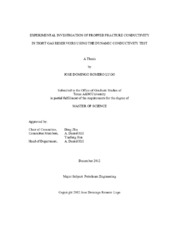| dc.description.abstract | Hydraulic Fracturing stimulation technology is used to increase the amount of oil and gas produced from low permeability reservoirs. The primary objective of the process is to increase the conductivity of the reservoir by the creation of fractures deep into the formation, changing the flow pattern from radial to linear flow. The dynamic conductivity test was used for this research to evaluate the effect of closure stress, temperature, proppant concentration, and flow back rates on fracture conductivity. The objective of performing a dynamic conductivity test is to be able to mimic actual field conditions by pumping fracturing fluid/proppant slurry fluid into a conductivity cell, and applying closure stress afterwards. In addition, a factorial design was implemented in order to determine the main effect of each of the investigated factors and to minimize the number of experimental runs. Due to the stochastic nature of the dynamic conductivity test, each experiment was repeated several times to evaluate the consistency of the results.
Experimental results indicate that the increase in closure stress has a detrimental effect on fracture conductivity. This effect can be attributed to the reduction in fracture width as closure stress was increased. Moreover, the formation of channels at low proppant concentration plays a significant role in determining the final conductivity of a fracture. The presence of these channels created an additional flow path for nitrogen, resulting in a significant increase in the conductivity of the fracture. In addition, experiments performed at high temperatures and stresses exhibited a reduction in fracture conductivity. The formation of a polymer cake due to unbroken gel dried up at high temperatures further impeded the propped conductivity.
The effect of nitrogen rate was observed to be inversely proportional to fracture conductivity. The significant reduction in fracture conductivity could possibly be due to the effect of polymer dehydration at higher flow rates and temperatures. However, there is no certainty from experimental results that this conductivity reduction is an effect that occurs in real fractures or whether it is an effect that is only significant in laboratory conditions. | en |


